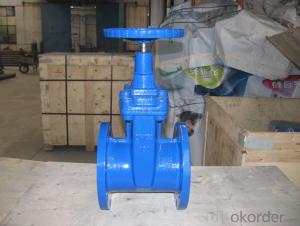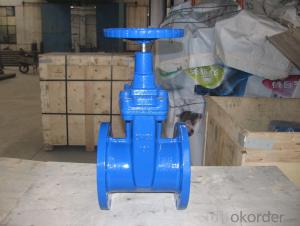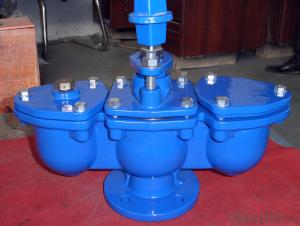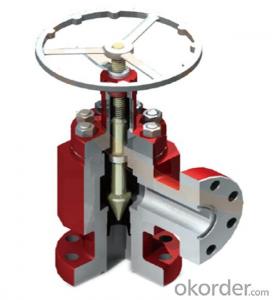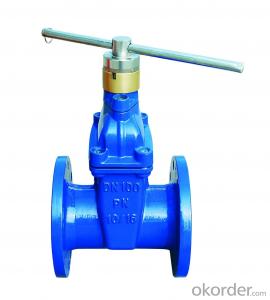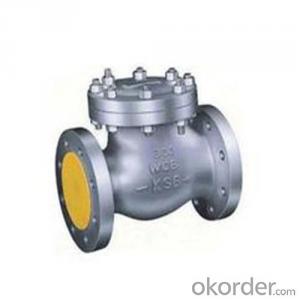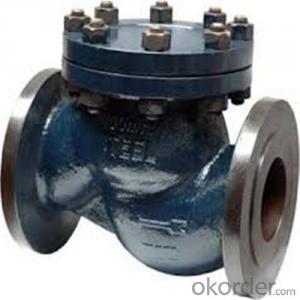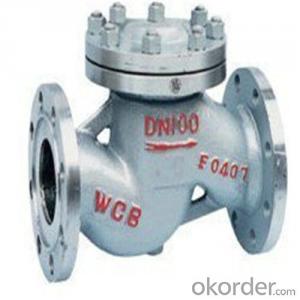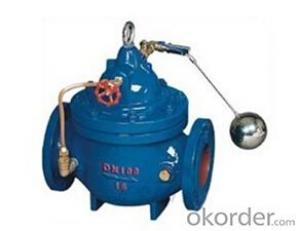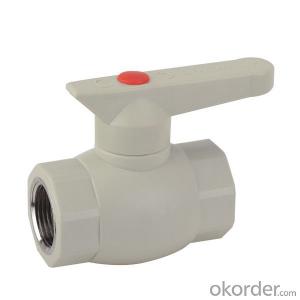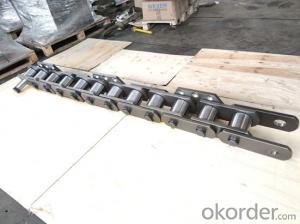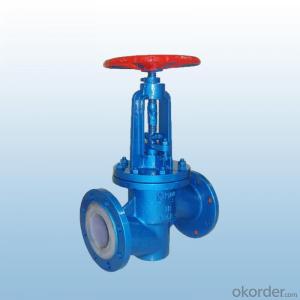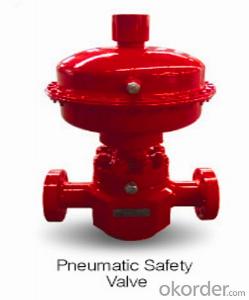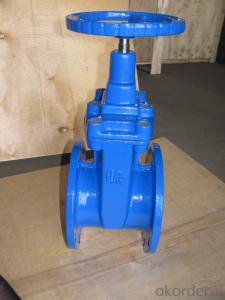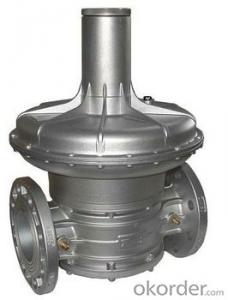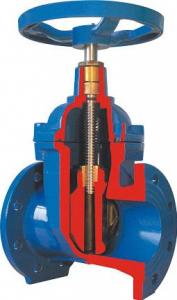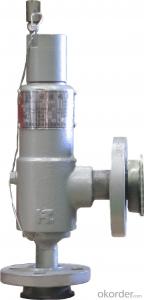Gate Valve of China Quality with Good Price
- Loading Port:
- China main port
- Payment Terms:
- TT or LC
- Min Order Qty:
- 1000 set
- Supply Capability:
- 50000 set/month
OKorder Service Pledge
OKorder Financial Service
You Might Also Like
1.Structure of Gate Valve Description:
1. Selected materials, in line with domestic and international standards, high overall quality of the material.
2. In line with the requirements of domestic and foreign advanced standards, reliable sealing, excellent performance, attractive appearance.
3. Sealing pair advanced and reasonable, gate and seat sealing surface with different hardness Stellite (Stellite) cobalt-based alloy cladding made, reliable sealing, high hardness, wear resistance, high temperature, corrosion good anti-abrasion performance, long life.
4. Stem quenched and nitride surface treatment, has good corrosion resistance, scratch resistance and abrasion resistance.
5. The use of flexible wedge gate structure, medium and large caliber set thrust bearings, friction force is small, and with a striking manually open and close with ease.
2.Main Features of the Gate Valve:
1)Full port design
2)OS&Y Outside screw and yoke .
3)BB. Bolted Bonnet .
4)Flexible wedge, Fully guided
5)Choice of solid or split wedge .
6)Renewable seat rings
3.Images of the Gate Valve:

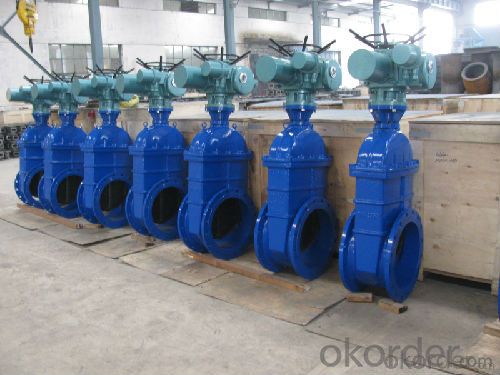
4.Specification of the Gate Valve:
1.Material:A105,A105N,F304,F304L,F316,F316L,LF2,F5,F11,F22,F347,F321,F51,Monel......
2.Size:≤3"
3.Pressure: Class150~2500
4.Design and Manufacture:API602,BS5352,ANSI B16.34
5.Test and Inspection:API598,GB/T13927,JB/T9092
6.Structure Features:
B.B(Bolted Bonnet) and OS&Y(Outside Screw and Yoke)
W.B(Welded Bonnet) and OS&Y(Outside Screw and Yoke)
5.FAQ
1. Can I get free samples?
A: Yes,we can provide you the free sample, but you need to bear their own delivery costs.
2. Can I request to change the form of packaging and transportation?
A:Yes, We can change the form of the packaging and transportation according to your request, but you have to bear their own costs incurred during this period and the spreads.
3. Can I request to advance the shipment?
A: It should be depends on whether there is sufficient inventory in our warehouse.
4. Can you produce the products according to my own drawings?
A:Yes,we can produce the products according to your drawings that will be most satisfy you.
- Q:The atrioventricular valves will be open whenA. Atria are in diastole and ventricles are in systole B. Pressure in the ventricles is greater than the pressure in the great arteries C. The ventricles are being passively filled D. The ventricles are in isovolumetric contraction
- Answer: (c) The ventricles are being passively filled. During diastole, a normally-functioning mitral valve opens as a result of increased pressure from the left atrium as it fills with blood (preloading). As atrial pressure increases above that of the left ventricle, the mitral valve opens. Opening facilitates the passive flow of blood into the left ventricle. Diastole ends with atrial contraction, which ejects the final 20% of blood that is transferred from the left atrium to the left ventricle. This amount of blood is known as end diastolic volume (EDV), and the mitral valve closes at the end of atrial contraction to prevent a reversal of blood flow. Mitral valve also opens when right ventricle is passively filled.
- Q:It's filling up a 5 gallon bucket roughly ever 9-10 hours. It was leaking with an old valve and has been replaced, and after being replaced it didn't stop. The temperature has not been adjusted higher or lower, it's exactly where it was for the year before the leak started. Any ideas?
- Instructions : 1 Shut off the power to water heater. If electric, turn gas to pilot setting, if a gas water heater. Cut off water supply to water heater as well. 2 Drain the water from tank to just below relief valve. It is not necessary to drain the entire tank. Open a hot water faucet, drain tank from tank drain for approximately three to five minutes. 3 Prepare the new relief valve with Teflon tape. Remove the dip tube and any other connections to the relief valve. Check faucet to make sure water is not running. A slow drip is OK. 4Unscrew the relief valve counter-clockwise with a wrench to remove. Install the new relief valve. Install the dip tube with a compression fitting, if you had to cut it to remove earlier. Make all other connections. 5. Turn the water supply back on to water heater. Make sure water is running from the open faucet before turning the power back on.
- Q:I have the correct tools and have done this before. All I want to do is change all three valves that operate the water (hot,diverter,cold). The shower is leaking. I want to change all three valves to stop the leak. I will call a plumber if I can't change the valves or stop the leak. Please tell me what tools I need and I'll begin from there. I have three handles/valves in the shower(cold,diverter,hot).The cold is here # and the diverter is in the center which is here # and the hot is here #. They all line up like this c# diverter# h#. These are how the valves are set up # # #.
- There is not three separate valves, it is basically a manifold with two shut off valves and a mixing valve all combined into one unit. Replacing the whole unit would be the easiest most efficient thing to do. What I'm thinking has happened is that the valves started to leak, and you kept tightening the handles in an effort to stop the flow, thereby stripping the handles, not the valves. Get a faucet handle puller, pull the handles, and remove the valve stems by undoing the packing nuts, there is also a seat reamer tool, resurface the seats and install new washers, buy new handles and you may not have to replace the whole diverter assembly. It will take more time but will be cheaper also.
- Q:After shutting off the hot and cold water lines to my washer to remove the unit from my laundry room i noticed a small leak coming from the hot water valve as if the valve is not completely closing. The valves themselves should be roughly 10 years old and were extremely tight when attempting to close them, my question is how big of a job is this to replace the water valve? Is it as simple as turning off the main water to the house and replacing the valve or are these typically soldered on? Currently i just ran the hose for the hot water to the drain line to prevent water from leaking onto the floor so is this something that is a fairly non issue once i hook the lines back up to the washer and turn them back on? Or is this something i should get addressed asap?
- Laundry Water Valve
- Q:I had the EGR valve and solenoid replaced and I'm not sure they needed to be replaced.
- The Exhaust Gas Recirculation valve allows a metered amount of exhaust to be drawn into the intake to be re-burned with the fuel and air mixture. The purpose for that is to introduce an inert gas to the mixture which lowers combustion temperatures. The reason for lowering combustion temperatures is to reduce the emissions of NOX from the tailpipe. I'm not sure if it needed to be replaced either, but if your check engine lamp doesn't come on anymore, then it probably did need it.
- Q:I was told on Tuesday that i have mitral valve prolapse and that i inherited it and that i will be fine. Well i take toporol xl 50 mg because the mitral valve prolapse makes my heart beat fast. For the past week i have noticed that my chest/lungs get tight, kind of like i have congestion in my chest, it comes and goes and sometimes its really bad and sometimes i can tolerate it. Is this normal for someone with the mitral valve condition. My cardiologist didn't go into details about the symptoms and i'm wondering if i should go see another doctor. I do have a sniffly nose and was wondering if this could be symptoms of a cold or something else. Any one out their with my condition having the same problems??? If so what is it???
- Haven't had it done before but: It's a pretty involved procedure. Patient is put under general anesthesia and is usually on the cardiopulmonary bypass machine (heart-lung machine) since you can't really replace a heart valve if the heart is beating. mortality for full valve replacement according to wiki is 6-8 percent, prob less than 5% for young healthy patients. Recently, many people have been doing the procedure laparoscopically. Patients are put into the surgical ICU for typically 1-2 days after the surgery. You can be discharged about a week after. Obviously there's risks, this is a very involved and definitely not a simple procedure. However, the cardiothoracic surgeons do these procedures every day for their entire lives-they're very skilled and qualified. good luck!
- Q:I went to the cardiologist yesterday and I was diagnosed with leaky aortic valve. I really want to know more information on it, but i cant find anything. I have two questions:- is aortic valve leakage and aortic valve regurgitation the same thing?- can somebody give me some background information or some articles for me to read so i know how to keep it minor?also heres some family history:My Dad- Arrhythmia, Heart Murmurs, something with Coronary ArtaryMy Mom- Mitral ValveMy (twin) brother- Bicupsive Valve My sister - she has heart papitations, but we dont know what it isim 15 year old girl (if it helps)and right now its not too serious
- it okorder /
- Q:2004 R6. Runs really well... never had a problem. Has 24K miles on it. Yamaha calls for them to get readjusted at the 26,600 mile mark. So I have a few thousand more and then I'm gunna have them adjusted.I can already hear them tick especially at idle because when riding, my exhaust is so loud and all you can hear is that and the wind. Anyway, this time will come up before I know it.Just curious... what happens if the valves remain loose? Will it affect performance? How do you they become loose and is it ok to ride a bike with them like that... atleast until the specific mileage when they are supposed to be adjustd?
- Your ears do not determine if a valve is loose. The feeler gauge determines if the valve is loose. A tight valve will burn. Check/replace camchain tensioners.
- Q:how do you adjust the hyd. valves when motor is running?? thanks, jerry swain
- that's puzzling to discover 0 clearance even as the lifters are not any more pumped up. it truly is how I actually have continuously lashed small block chevys, even with the actual undeniable actuality that it may get messy. get rid of one million valve hide, start up engine. Tighten the first rocker nut till the push rod stops spinning lower than the rocker. Then decrease backpedal a million/4-a million/2 turn. Repeat for each and each of the others. This works nicely with new valve practice factors to boot to boot used parts. the downside is oil would drip on warm headers.
- Q:I bought a plastic ball valve from Lowe's just a couple days ago and it is stuck, I haven't installed it in anything but it wont budge without a pair of channel locks. I tried wd-40 but still nothing, should I return it or keep working with it? and if I keep working what should I try?
- === take it back and get another valve .... if it doesn't work freely in your hand then the valve will be a problem if you install it ---- working with pvc you should use the purple glue that is waterproof and it is a good seal and no leaks when you have
1. Manufacturer Overview |
|
|---|---|
| Location | |
| Year Established | |
| Annual Output Value | |
| Main Markets | |
| Company Certifications | |
2. Manufacturer Certificates |
|
|---|---|
| a) Certification Name | |
| Range | |
| Reference | |
| Validity Period | |
3. Manufacturer Capability |
|
|---|---|
| a)Trade Capacity | |
| Nearest Port | |
| Export Percentage | |
| No.of Employees in Trade Department | |
| Language Spoken: | |
| b)Factory Information | |
| Factory Size: | |
| No. of Production Lines | |
| Contract Manufacturing | |
| Product Price Range | |
Send your message to us
Gate Valve of China Quality with Good Price
- Loading Port:
- China main port
- Payment Terms:
- TT or LC
- Min Order Qty:
- 1000 set
- Supply Capability:
- 50000 set/month
OKorder Service Pledge
OKorder Financial Service
Similar products
New products
Hot products
Related keywords
